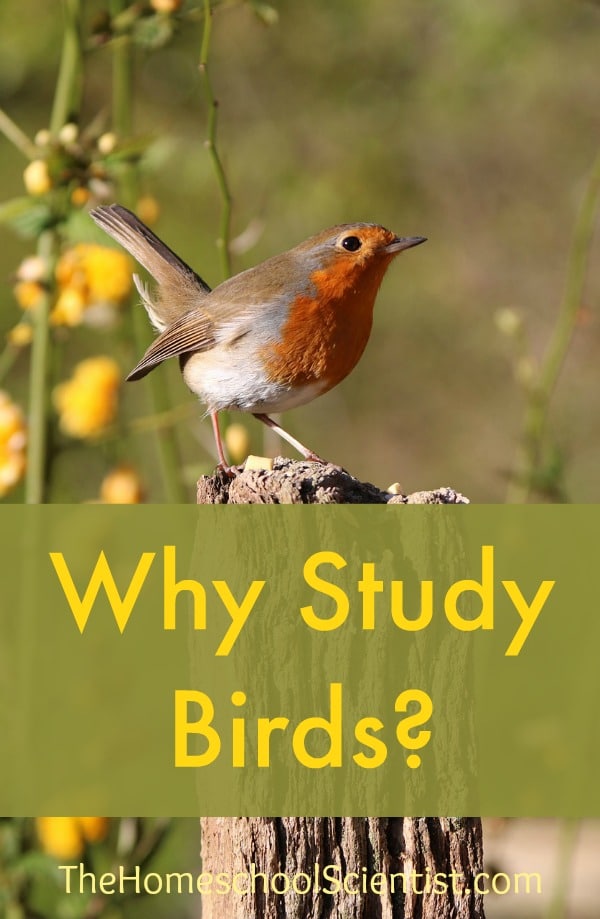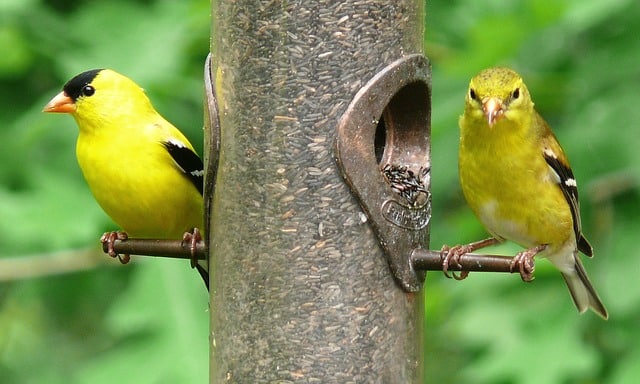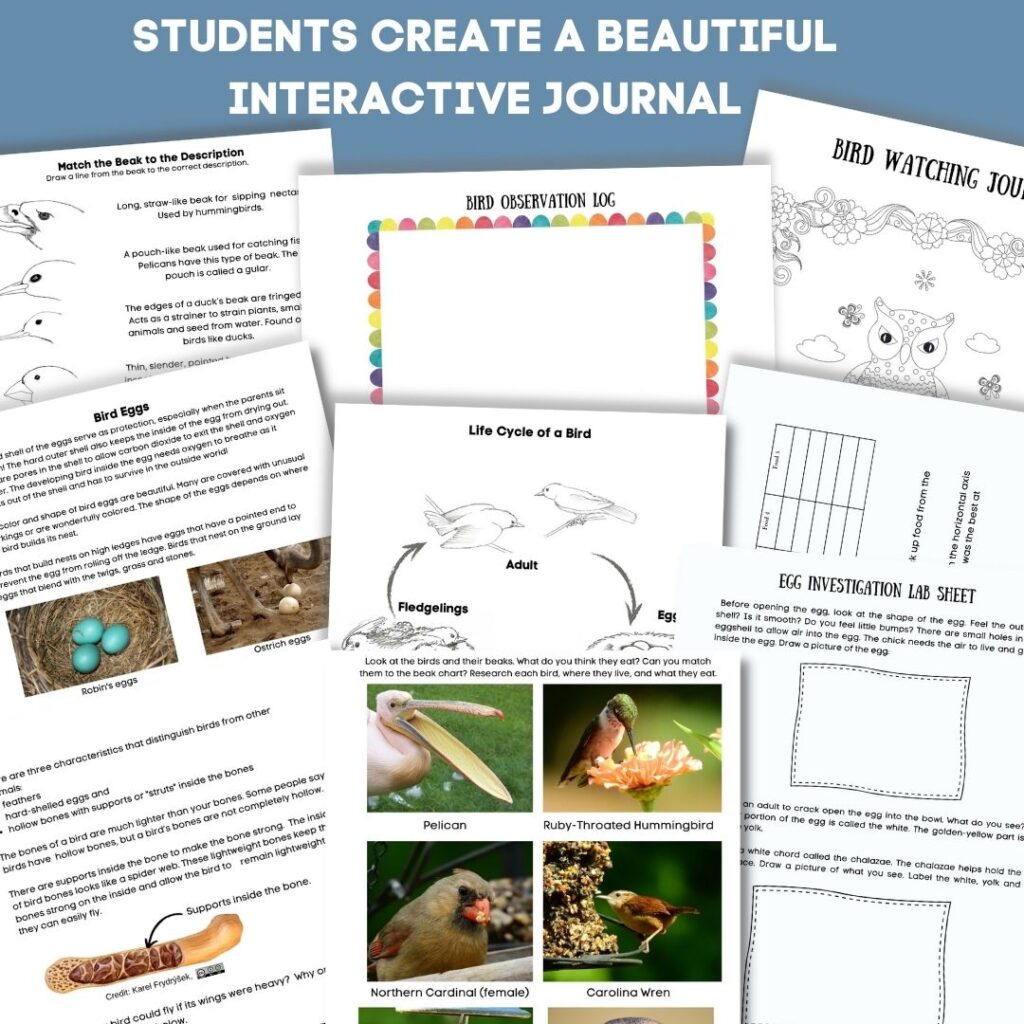Why Study Backyard Birds
Growing up, we lived in a rural area with woods behind the house and farmland in front. We had a lake on our property that was just 15 miles from the Mississippi River. Wildlife of all sorts thrived there.
There were always raccoon and opossum hanging around the barns and the chicken coops. Deer were everywhere. Muskrat and turtles were ever present in our lake. I was used to seeing many types of birds at the bird feeders and other types of birds around the water, but it took years for me to realize just how many different species of birds could be found on that small piece of property.
(Don’t miss the free bird printable pack at the end of the post!)

The Wonder Of Backyard Birds
When I was in college, the birds caught my attention. One summer, I was back home and my dad mentioned the fact that the Baltimore Orioles had made a nest in the huge shagbark hickory tree by the driveway again. Then, he mentioned the finches that were already looking for seeds in the flower beds and the black and white bird with the red patch on the wing that he hadn’t seen in years was at the feeder that morning. This got me curious about how many birds could be seen right in our yard.
That next day, I bought a Petersen’s Field Guide To Birds Of Eastern North America. (That started my obsession with field guides!) I decided that I would watch the feeders in the yard and write down what birds I observed.
Check out our easy-to-do (and inexpensive!) bird feeders.
I started by just watching the bird feeders from the window a couple times a day so I wouldn’t scare the birds. Then, I noticed that many of them birds would visit the feeders if we were outside, just not too close. I was surprised by the number of different types of birds I saw in just the first two weeks. Some types were regulars and every one in a while, a new visitor would appear.

As I sat in the yard one day watching the feeders, I started to notice birds in surrounding trees and grass that didn’t visit the feeders. I wondered what other birds were on our property, but stayed away from the feeders and the open area around them.
I began to visit the woods behind the house, the shore of the lake, and the farm fields surrounding us. I sat, observed, and recorded. At the end of the summer, I had identified over 40 different types of birds on our 15 acres of property. I was hooked on birding.
Why Study Birds?
In all my years of studying nature, I have not found anything that is easier and more rewarding than studying birds. Ever since that summer observing birds in our backyard, I have been hooked.
What started out as curiosity and wonder, has turned into respect and, also, concern. I have found birds can be studied purely for enjoyment in your backyard. They can, also, also be studied as part of a larger ecological picture. So, what makes birds so great to study and why should you study birds?
Birds are easy to find. Think about it. Where do you not see birds? Look out your window. Visit a park. Walk in the woods. Take a trip to the desert, the beach, or the mountains. You will find birds. The ease of accessibility to birds makes them prime candidates to study.
Birds are beautiful. It’s ok to study something just because its pretty. You have to be drawn by something. Attraction is why birds have beautiful colors and interesting mating rituals. The beauty is what attracts you. Cornell School of Ornithology has excellent information on the color of bird feathers.
Birds can fly. That might be enough right there. Seriously. They are animals that fly. Who doesn’t want to fly? Who isn’t captivated by flight? The designers of airplanes study the aerodynamics of birds to make better airplanes.
Birds are diverse. Looking out my window into my backyard right now I can see several diverse species of birds. They are all birds and have the same basic characteristics, but they are very diverse.
The robin with its dark brown/gray back and red breast is hopping in the grass searching for worms or bugs for its lunch. The smaller eastern pewee is gray with a light breast. It is flying from a perch in a walnut tree over the yard catching bugs in mid-air. A small black and white downy woodpecker is drilling its beak into a dead elm tree searching for bugs living under the bark.
All so similar, yet so different.
Birds can serve as important environmental indicators. Do you remember the stories of miners keeping canaries with them deep in the mines? If dangerous gases were present in the mines, the canary would dies. This served as a warning for the miners to evacuate or meet the same fate.
Declines in whole bird populations can be indicators of dangerous pollutants present in the environment. In the 1970s, populations of birds such as bald eagles met a rapid decline. The pesticide DDT was found to be the culprit. The dangers of DDT to animal populations, including humans, was unknown until the unexplained decline of bird numbers was studied. DDT was subsequently banned in the U.S. because of the damage it did to the bird populations.
Fluctuations in bird populations can indicated ecosystem changes. The National Audubon Society report Common Birds in Decline reports that some bird species have decreased in number as much as 80 percent since 1967, and the 19 others in the report have lost half their populations. This unsettling decline in population numbers have prompted scientist to search for causes. They have found habitat loss as the major culprit and are working on ways to conserve important bird habitats.
Download the Free Printable Pack
Are you ready to start your backyard bird study? Enjoy our 60+ page Birds of a Feather learning resource.
- My Favorite Bird Apps
- Notebooking Backyard Birds
- Attracting Birds To Your Backyard
- Easy To Make Bird Feeders
- Bald Eagle Unit Study Ideas
- The Great Backyard Bird Count
- Hands-On Bird Nest Study
- Birding Apps
More Backyard Science
- Capturing Animal Tracks
- Square Foot Nature Study
- Leaf Unit Study Resources
- Nature Observation Printables
- Parts Of A Flower Lesson Printable
- Square Foot Gardening
- Hands-On Spider Study
- Apps For Exploring Nature
I hold a master’s degree in child development and early education and am working on a post-baccalaureate in biology. I spent 15 years working for a biotechnology company developing IT systems in DNA testing laboratories across the US. I taught K4 in a private school, homeschooled my children, and have taught on the mission field in southern Asia. For 4 years, I served on our state’s FIRST Lego League tournament Board and served as the Judging Director. I own thehomeschoolscientist and also write a regular science column for Homeschooling Today Magazine. You’ll also find my writings on the CTCMath blog. Through this site, I have authored over 50 math and science resources.



